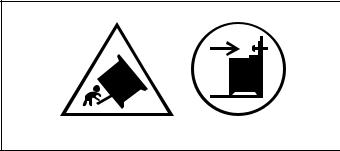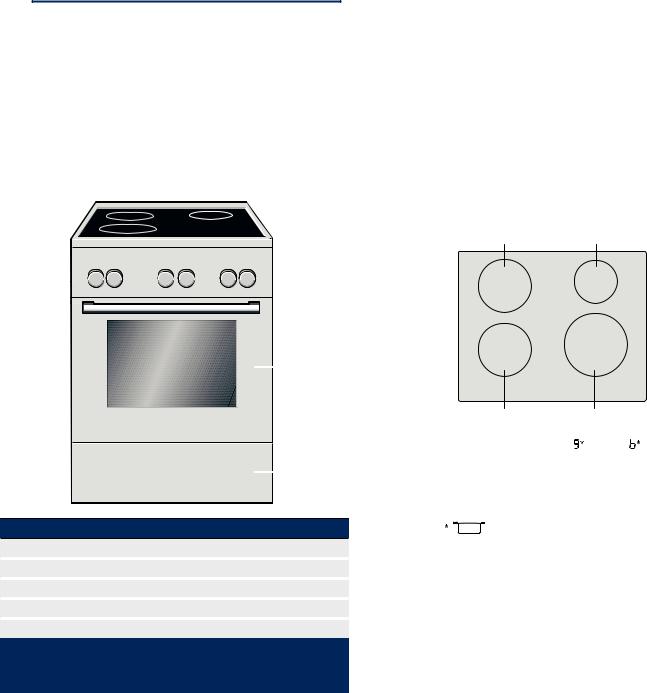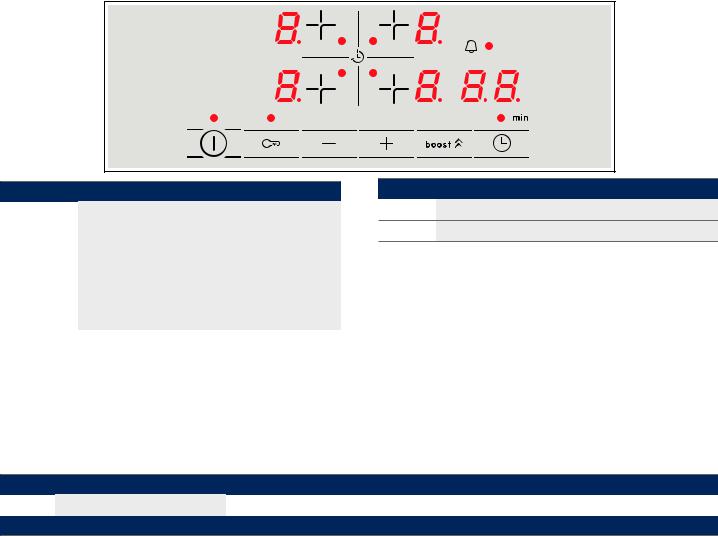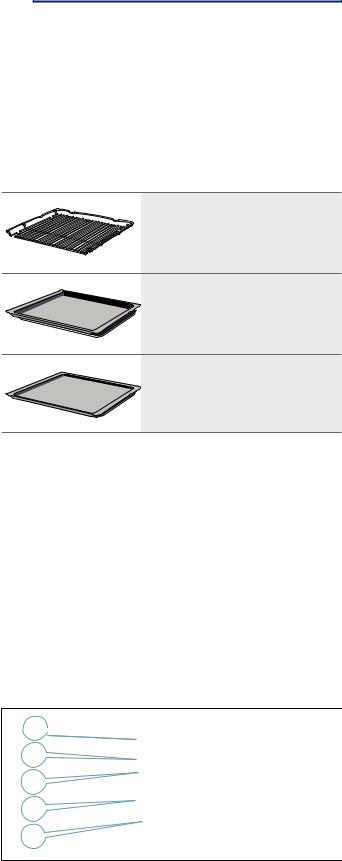Bosch HLL09A020U Instructions for Use

3FHJTUFS ZPVS . OFXEFWJDFPO Z#PTDIOPXBOE HFUGSFFCFOFGJUT CPTDI IPNF DPN XFMDPNF
Free standing cooker
HLL09A020U
[en] Instruction manual |
Free standing cooker |
Table of contents
8Intended use . . . . . . . . . . . . . . . . . . . . . . . . . . . . . 4
(Important safety information . . . . . . . . . . . . . . . 5
Halogen lamp. . . . . . . . . . . . . . . . . . . . . . . . . . . . . . . . 6
]Causes of damage . . . . . . . . . . . . . . . . . . . . . . . . |
7 |
Hob . . . . . . . . . . . . . . . . . . . . . . . . . . . . . . . . . . . . . . |
7 |
Damage to the oven. . . . . . . . . . . . . . . . . . . . . . . . . . . |
7 |
Damage to the plinth drawer . . . . . . . . . . . . . . . . . . . . |
7 |
7Environmental protection . . . . . . . . . . . . . . . . . . 8
Saving energy . . . . . . . . . . . . . . . . . . . . . . . . . . . . . . . 8 Energy-saving advice . . . . . . . . . . . . . . . . . . . . . . . . . . 8 Environmentally-friendly disposal . . . . . . . . . . . . . . . . . 9
fInduction cooking . . . . . . . . . . . . . . . . . . . . . . . . 9
Advantages of induction cooking. . . . . . . . . . . . . . . . . 9 Cookware. . . . . . . . . . . . . . . . . . . . . . . . . . . . . . . . . . . 9
5Installation and connection. . . . . . . . . . . . . . . . 10
Electrical connection . . . . . . . . . . . . . . . . . . . . . . . . . 10 Removing the appliance . . . . . . . . . . . . . . . . . . . . . . 11 Adjacent units . . . . . . . . . . . . . . . . . . . . . . . . . . . . . . 11 Wall fixing. . . . . . . . . . . . . . . . . . . . . . . . . . . . . . . . . . 11 Door lock . . . . . . . . . . . . . . . . . . . . . . . . . . . . . . . . . . 11 Measures to be noted during transport . . . . . . . . . . . 11
*Getting to know your appliance . . . . . . . . . . . . 12
General information . . . . . . . . . . . . . . . . . . . . . . . . . . 12 Cooking area . . . . . . . . . . . . . . . . . . . . . . . . . . . . . . . 12 Control panel . . . . . . . . . . . . . . . . . . . . . . . . . . . . . . . 14 Cooking compartment . . . . . . . . . . . . . . . . . . . . . . . . 15
_Accessories . . . . . . . . . . . . . . . . . . . . . . . . . . . . 15
Accessories included . . . . . . . . . . . . . . . . . . . . . . . . . 15 Inserting accessories . . . . . . . . . . . . . . . . . . . . . . . . . 15 Optional accessories . . . . . . . . . . . . . . . . . . . . . . . . . 16
KBefore using for the first time. . . . . . . . . . . . . . 17
Cleaning the cooking compartment and accessories 17
1Operating the appliance . . . . . . . . . . . . . . . . . . 17
Switching the hob on and off . . . . . . . . . . . . . . . . . . . 17 Setting a hotplate . . . . . . . . . . . . . . . . . . . . . . . . . . . . 17 Chef's recommendations . . . . . . . . . . . . . . . . . . . . . . 18
OTime-setting options . . . . . . . . . . . . . . . . . . . . . 20
Programming the cooking time . . . . . . . . . . . . . . . . . 20 The kitchen timer . . . . . . . . . . . . . . . . . . . . . . . . . . . . 20
vPowerBoost function . . . . . . . . . . . . . . . . . . . . . 21
Activation . . . . . . . . . . . . . . . . . . . . . . . . . . . . . . . . . . 21 Deactivation . . . . . . . . . . . . . . . . . . . . . . . . . . . . . . . . 21
en
AChildproof lock. . . . . . . . . . . . . . . . . . . . . . . . . . 22
Activating and deactivating the childproof lock . . . . .22 Childproof lock . . . . . . . . . . . . . . . . . . . . . . . . . . . . . .22
bAutomatic safety cut-out . . . . . . . . . . . . . . . . . . 22
QBasic settings. . . . . . . . . . . . . . . . . . . . . . . . . . . 23
To access the basic settings: . . . . . . . . . . . . . . . . . . .24 tCookware check. . . . . . . . . . . . . . . . . . . . . . . . . 24
hPower manager . . . . . . . . . . . . . . . . . . . . . . . . . 25
1Operating the appliance . . . . . . . . . . . . . . . . . . 25
Switching the appliance on and off . . . . . . . . . . . . . .25 Setting the type of heating and temperature. . . . . . . .25 Rapid heating . . . . . . . . . . . . . . . . . . . . . . . . . . . . . . .26
DCleaning . . . . . . . . . . . . . . . . . . . . . . . . . . . . . . . 26
Cleaning agents . . . . . . . . . . . . . . . . . . . . . . . . . . . . .26 Surfaces in the cooking compartment . . . . . . . . . . . .28 Keeping the appliance clean . . . . . . . . . . . . . . . . . . .29
pRails. . . . . . . . . . . . . . . . . . . . . . . . . . . . . . . . . . . 29
Detaching and refitting the rails . . . . . . . . . . . . . . . . .29
qAppliance door . . . . . . . . . . . . . . . . . . . . . . . . . . 30
Detaching and attaching the oven door . . . . . . . . . . .30 Removing and installing the door panels . . . . . . . . . .30 Additional door safety. . . . . . . . . . . . . . . . . . . . . . . . .31
{Frequently Asked Questions (FAQ) . . . . . . . . . 32
3Trouble shooting . . . . . . . . . . . . . . . . . . . . . . . . 33
Malfunction table . . . . . . . . . . . . . . . . . . . . . . . . . . . .34
Replacing the bulb in the top of the cooking compartment . . . . . . . . . . . . . . . . . . . . . . . . . . . . . . .34
4Customer service . . . . . . . . . . . . . . . . . . . . . . . . 35
E number and FD number . . . . . . . . . . . . . . . . . . . . .35
3

en Intended use
JTested for you in our cooking studio. . . . . . . . 35
General information . . . . . . . . . . . . . . . . . . . . . . . . . .35 Cakes and pastries . . . . . . . . . . . . . . . . . . . . . . . . . .36 Bakes and gratins . . . . . . . . . . . . . . . . . . . . . . . . . . .39 Poultry, meat and fish. . . . . . . . . . . . . . . . . . . . . . . . .40 Vegetables and side dishes . . . . . . . . . . . . . . . . . . . .42 Yoghurt. . . . . . . . . . . . . . . . . . . . . . . . . . . . . . . . . . . .43 Acrylamide in foodstuffs. . . . . . . . . . . . . . . . . . . . . . .43 Drying. . . . . . . . . . . . . . . . . . . . . . . . . . . . . . . . . . . . .43 Preserving . . . . . . . . . . . . . . . . . . . . . . . . . . . . . . . . .44 Prove dough. . . . . . . . . . . . . . . . . . . . . . . . . . . . . . . .45 Defrosting. . . . . . . . . . . . . . . . . . . . . . . . . . . . . . . . . .45 Test dishes. . . . . . . . . . . . . . . . . . . . . . . . . . . . . . . . .46
Additional information on products, accessories, replacement parts and services can be found at www.bosch-home.com and in the online shop
www.bosch-eshop.com
8Intended use
Read these instructions carefully. Only then will you be able to operate your appliance safely and correctly. Retain the instruction manual and installation instructions for future use or for subsequent owners.
The images shown in these instructions are for guidance only.
Check the appliance for damage after unpacking it. Do not connect the appliance if it has been damaged in transport.
Only a licensed professional may connect appliances without plugs. Damage caused by incorrect connection is not covered under warranty.
This appliance is intended for private domestic use and the household environment only. The appliance must only be used for the preparation of food and beverages. The cooking process must be supervised. A short cooking process must be supervised without interruption. Only use the appliance in enclosed spaces.
This appliance is intended for use up to a maximum height of 4000 metres above sea level.
This appliance is not designed for operation with an external timer or by remote control.
Do not use inappropriate child safety shields or hob guards. These can cause accidents.
This appliance may be used by children over the age of 8 years old and by persons with reduced physical, sensory or mental capabilities or by persons with a lack of experience or knowledge if they are supervised or are instructed by a person responsible for their safety how to use the appliance safely and have understood the associated hazards.
Children must not play with, on, or around the appliance. Children must not clean the appliance or carry out general maintenance unless they are at least 15 years old and are being supervised.
Keep children below the age of 8 years old at a safe distance from the appliance and power cable.
We advise that you exercise caution using or standing near an induction hob while it is in operation, if you wear a pacemaker or a similar medical device. Consult your doctor or
4

the device manufacturer concerning its conformity or any possible incompatibilities,
Always slide accessories into the cooking compartment the right way round.
~ "Accessories" on page 15
(Important safety information
:Warning – Risk of fire!
■Combustible items stored in the cooking compartment may catch fire. Never store combustible items in the cooking compartment. Never open the appliance door if there is smoke inside. Switch off the appliance and unplug it from the mains or switch off the circuit breaker in the fuse box.
■A draught is created when the appliance door is opened. Greaseproof paper may come into contact with the heating element and catch fire. Do not place greaseproof paper loosely over accessories during preheating. Always weight down the greaseproof paper with a dish or a baking tin. Only cover the surface required with greaseproof paper. Greaseproof paper must not protrude over the accessories.
■Hot oil and fat can ignite very quickly. Never leave hot fat or oil unattended. Never use water to put out burning oil or fat. Switch off the hotplate. Extinguish flames carefully using a lid, fire blanket or something similar.
■The hotplates become very hot. Never place combustible items on the hob. Never place objects on the hob.
■The appliance becomes very hot, and flammable materials can easily catch fire.
Do not store or use any flammable objects (e.g. aerosol cans, cleaning agents) under or in the vicinity of the oven. Do not store any flammable objects inside or on top of the oven.
■The surfaces of the plinth drawer may become very hot. Only store oven accessories in the drawer. Flammable and combustible objects must not be stored in the plinth drawer.
■The hob switches off automatically and can no longer be operated. It may switch on unintentionally at a later point. Switch off the circuit breaker in the fuse box. Contact the after-sales service.
Important safety information |
en |
:Warning – Risk of burns!
■The appliance becomes very hot. Never touch the interior surfaces of the cooking compartment or the heating elements. Always allow the appliance to cool down. Keep children at a safe distance.
■Accessories and ovenware become very hot. Always use oven gloves to remove accessories or ovenware from the cooking compartment.
■Alcoholic vapours may catch fire in the hot cooking compartment. Never prepare food containing large quantities of drinks with a high alcohol content. Only use small quantities of drinks with a high alcohol content. Open the appliance door with care.
■The hotplates and surrounding area (particularly the hob surround, if fitted) become very hot. Never touch the hot surfaces. Keep children at a safe distance.
■During operation, the surfaces of the appliance become hot. Do not touch the surfaces when they are hot. Keep children away from the appliance.
■The hotplate heats up but the display does not work. Switch off the circuit breaker in the fuse box. Contact the after-sales service.
■The appliance becomes hot during operation. Allow the appliance to cool down before cleaning.
■Metal objects on the hob quickly become very hot. Never place metal objects (such as knives, forks, spoons and lids) on the hob.
■After each use, always turn off the hob at the main switch. Do not wait until the hob turns off automatically after the pan is removed.
:Warning – Risk of scalding!
■The accessible parts become hot during operation. Never touch the hot parts. Keep children at a safe distance.
■When you open the appliance door, hot steam can escape. Steam may not be visible, depending on its temperature. When opening, do not stand too close to the appliance. Open the appliance door carefully. Keep children away.
■Water in a hot cooking compartment may create hot steam. Never pour water into the cooking compartment when the cooking compartment is hot.
5

en Important safety information
:Warning – Risk of injury!
■Scratched glass in the appliance door may develop into a crack. Do not use a glass scraper, sharp or abrasive cleaning aids or detergents.
■When cooking in a bain marie, the hob and cooking container could shatter due to overheating. The cooking container in the bain marie must not directly touch the bottom of the water-filled pot. Only use heatresistant cookware.
■Saucepans may suddenly jump due to liquid between the pan base and the hotplate. Always keep the hotplate and saucepan bases dry.
■If the appliance is placed on a base and is not secured, it may slide off the base. The appliance must be fixed to the base.
■If you leave the appliance door open, people may bump into it, resulting in injury. The appliance door must be kept closed both while the appliance is in operation and when it has finished.
:Warning – Risk of tipping!
Warning: In order to prevent tipping of the appliance, this stabilizing means must be installed. Refer to the instructions for installation.
:Warning – Risk of electric shock!
■Incorrect repairs are dangerous. Repairs may only be carried out and damaged power cables replaced by one of our trained after-sales technicians. If the appliance is defective, unplug the appliance from the mains or switch off the circuit breaker in the fuse box. Contact the aftersales service.
■The cable insulation on electrical appliances may melt when touching hot parts of the appliance. Never bring electrical appliance cables into contact with hot parts of the appliance.
■Do not use any high-pressure cleaners or steam cleaners, which can result in an electric shock.
■A defective appliance may cause electric shock. Never switch on a defective appliance. Unplug the appliance from the mains or switch off the circuit breaker in the fuse box. Contact the after-sales service.
■Cracks or fractures in the glass ceramic may cause electric shocks. Switch off the circuit breaker in the fuse box. Contact the after-sales service.
■When disconnecting the appliance from the mains, the connections may cause residual voltages. Only allow a professional to connect the appliance.
Halogen lamp
:Warning – Risk of burns!
The bulbs in the cooking compartment become very hot. There is still a risk of burning your skin for some time after they have been switched off. Do not touch the glass cover. Avoid contact with your skin when cleaning.
:Warning – Risk of electric shock!
When replacing the cooking compartment bulb, the bulb socket contacts are live. Before replacing the bulb, unplug the appliance from the mains or switch off the circuit breaker in the fuse box.
6

Causes of damage |
en |
]Causes of damage
Hob
Caution!
■Rough pan bases may scratch the hob.
■Avoid leaving empty pots and pans on the hotplate. Doing so may cause damage.
■Do not place hot pans on the control panel, the indicator area, or the hob frame. Doing so may cause damage.
■Hard or pointed objects dropped on the hob may damage it.
■Aluminium foil and plastic containers will melt if placed on the hotplate while it is hot. The use of laminated sheeting is not recommended on the hob.
Overview
You will find the most frequently caused damage in the following table:
Damage |
Cause |
Measure |
Stains |
Boiled over food. |
Remove boiled over food immediately with a glass scraper. |
|
Unsuitable cleaning agent. |
Only use cleaning agents that are suitable for this type of hob. |
Scratches |
Salt, sugar and sand. |
Do not use the hob as a work surface or storage space. |
|
Cookware with rough bases scratch the hob. |
Check the cookware. |
Discolouration |
Unsuitable cleaning agent. |
Only use cleaning agents that are suitable for this type of hob. |
|
Pan abrasion. |
Lift pots and pans when moving them. |
Chips |
Sugar, food with a high sugar content. |
Remove boiled over food immediately with a glass scraper. |
|
|
|
Damage to the oven
Caution!
■Accessories, foil, greaseproof paper or ovenware on the cooking compartment floor: do not place accessories on the cooking compartment floor. Do not cover the cooking compartment floor with any sort of foil or greaseproof paper. Do not place ovenware on the cooking compartment floor if a temperature of over 50 ºC has been set. This will cause heat to accumulate. The baking and roasting times will no longer be correct and the enamel will be damaged.
■Aluminium foil: Aluminium foil in the cooking compartment must not come into contact with the door glass. This could cause permanent discolouration of the door glass.
■Water in a hot cooking compartment: do not pour water into the cooking compartment when it is hot. This will cause steam. The temperature change can cause damage to the enamel.
■Moisture in the cooking compartment: Over an extended period of time, moisture in the cooking compartment may lead to corrosion. Allow the cooking compartment to dry after use. Do not keep moist food in the closed cooking compartment for extended periods of time. Do not store food in the cooking compartment.
■Cooling with the appliance door open: Following operation at high temperatures, only allow the cooking compartment to cool down with the door closed. Do not trap anything in the appliance door. Even if the door is only left open a crack, the front of nearby furniture may become damaged over time. Only leave the cooking compartment to dry with the door open if a lot of moisture was produced whilst the oven was operating.
■Fruit juice: when baking particularly juicy fruit pies, do not pack the baking tray too generously. Fruit juice dripping from the baking tray leaves stains that cannot be removed. If possible, use the deeper universal pan.
■Extremely dirty seal: If the seal is very dirty, the appliance door will no longer close properly during operation. The fronts of adjacent units could be damaged. Always keep the seal clean. Never operate the appliance if the seal is damaged or missing. ~ "Cleaning" on page 26
■Appliance door as a seat, shelf or worktop: Do not sit on the appliance door, or place or hang anything on it. Do not place any cookware or accessories on the appliance door.
■Inserting accessories: depending on the appliance model, accessories can scratch the door panel when closing the appliance door. Always insert the accessories into the cooking compartment as far as they will go.
■Carrying the appliance: do not carry or hold the appliance by the door handle. The door handle cannot support the weight of the appliance and could break.
■Grilling: do not insert the baking tray or universal pan higher than level 3 when grilling. The high heat distorts it and the enamel may be damaged when it is removed. At level 4 and 5, only grill directly on the wire rack.
Damage to the plinth drawer
Caution!
Do not place hot objects in the plinth drawer. It could be damaged.
7

en Environmental protection
7Environmental protection
Your new appliance is particularly energy-efficient. Here you can find tips on how to save even more energy when using the appliance, and how to dispose of your appliance properly.
Saving energy
■Only preheat the appliance if this is specified in the recipe or in the tables in the operating instructions.
■Leave frozen food to defrost before placing it in the cooking compartment.
■Use baking tins that are dark-coloured, painted black or have an enamel coating. These absorb the heat particularly well.
■Remove any unnecessary accessories from the cooking compartment.
■Open the appliance door as infrequently as possible when the appliance is in use.
■It is best to bake several cakes one after the other. The cooking compartment stays warm. This reduces the baking time for the second cake. You can place two cake tins next to each other in the cooking compartment.
■For longer cooking times, you can switch the appliance off 10 minutes before the end of the cooking time and use the residual heat to finish cooking.
Energy-saving advice
■Always use the correct lid for each pan. Cooking without a lid uses a lot more energy. Use a glass lid to provide visibility and avoid having to lift the lid.
■Use pans with flat bases. Bases that are not flat use a lot more energy.
■The diameter of the pan base must match the size of the hotplate. Please note: pan manufacturers usually provide the diameter for the top of the pan, which is usually larger than the diameter of the pan base.
■Use a small pan for small amounts of food. A large pan which is not full uses a lot of energy.
■Use little water when cooking. This saves energy and preserves all the vitamins and minerals in vegetables.
■Select the lowest power level to maintain cooking. If the power level is too high, energy is wasted.
8

Environmentally-friendly disposal
Dispose of packaging in an environmentally-friendly manner.
This appliance is labelled in accordance with European Directive 2012/19/EU concerning used electrical and electronic appliances (waste electrical and electronic equipment - WEEE). The guideline determines the framework for the return and recycling of used appliances as applicable throughout the EU.
Induction cooking |
en |
fInduction cooking
Advantages of induction cooking
Induction cooking is very different from traditional cooking methods, as heat builds up directly in the item of cookware. This offers numerous advantages:
■Saves time when boiling and frying.
■Saves energy.
■Easier to care for and clean. Spilled food does not burn on as quickly.
■Heat control and safety – the hob increases or decreases the heat supply as soon as the user changes the setting. The induction hotplate stops the heat supply as soon as the cookware is removed from the hotplate, without having to switch it off first.
Cookware
Only use ferromagnetic cookware for induction cooking, such as:
■Cookware made from enamelled steel
■Cookware made from cast iron
■Special induction-compatible cookware made from stainless steel.
To check whether your cookware is suitable for induction cooking, refer to the section on
~ "Cookware check".
To achieve a good cooking result, the ferromagnetic area on the base of the pan should match the size of the hotplate. If a hotplate does not detect an item of cookware, try placing it on another hotplate with a smaller diameter.
FP |
FP |
FP |
Some induction cookware does not have a fully ferromagnetic base:
■If the base of the cookware is only partially ferromagnetic, only the area that is ferromagnetic will heat up. This may mean that heat will not be distributed evenly. The non-ferromagnetic area may not heat up to a sufficient temperature for cooking.
■The ferromagnetic area will also be reduced if the material from which the base of the cookware is made contains aluminium, for example. This may mean that the cookware will not become sufficiently hot or even that it will not be detected.
9

en Installation and connection
Unsuitable pans
Never use diffuser hobs or pans made from:
■common thin steel
■glass
■earthenware
■copper
■aluminium
Properties of the base of the cookware
The material(s) from which the base of the cookware is made can affect the cooking result. Using pots and pans made from materials that distribute heat evenly through them, such as stainless-steel pans with a threelayer base, saves time and energy.
Use cookware with a flat base; if the base of the cookware is uneven, this may impair the heat supply.
Absence of pan or unsuitable size
If no pan is placed on the selected hotplate, or if it is made of unsuitable material or is not the correct size, the power level displayed on the hotplate indicator will flash. Place a suitable pan on the hotplate to stop the flashing. If this takes more than 90 seconds, the hotplate will switch off automatically.
Empty pans or those with a thin base
Do not heat empty pans, nor use pans with a thin base. The hob is equipped with an internal safety system. However, an empty pan may heat up so quickly that the "automatic switch off" function may not have time to react and the pan may reach very high temperatures. The base of the pan could melt and damage the glass on the hob. In this case, do not touch the pan and switch the hotplate off. If it fails to work after it has cooled down, please contact the Technical Assistance Service.
Pan detection
Each hotplate has a lower limit for pan detection. This depends on the diameter of the ferromagnetic area of the cookware and the material from which its base is made. For this reason, you should always use the hotplate that best matches the diameter of the base of the pan.
5Installation and connection
Do not install the appliance behind a decorative door or the door of a kitchen unit, as this may cause the appliance to overheat.
Electrical connection
Only licensed specialists may connect the appliance.It is important that you comply with the requirements of your electricity supplier.
Any damage arising from the appliance being connected incorrectly will invalidate the warranty.
Caution!
Your appliance comes with the enclosed cable for permanently connecting it to the mains electricity supply.
Except in the event of damage, never remove the cable from the appliance or replace it with another cable (with or without plug).
Caution!
If the supply cord is damaged, it must be replaced by the manufacturer, its service agent or similarly qualified persons in order to avoid a hazard.
:Warning – Danger of death!
There is a risk of electric shock if you touch live components.
■Always make sure your hands are dry when you touch or hold the mains plug.
■Only pull out the mains cable by taking hold of the plug and removing the plug; never pull it out by the mains cable itself, as this could damage it.
■Never unplug the mains plug when the appliance is in operation.
Please note the following information and ensure that:
Notes
■The mains plug fits the socket.
■The cable cross section is adequate.
■The earthing system is properly installed.
■The mains cable is only replaced by a qualified electrician (if this is necessary).Spare mains cables can be ordered from our after-sales service.
■No power strips/multi-way connectors or extension cables are used.
■If using a residual current device, only use one that bears the mark z.
The presence of this mark is the only way to be sure that it fulfils all the applicable regulations.
■The mains plug can be accessed at all times.
■The mains cable is not kinked, crushed, modified or severed.
■The mains cable does not come into contact with heat sources.
10

For the installer
■An all-pole isolating switch with a contact gap of at least 3 mm must be present in the installation circuit. This is not necessary if the appliance is connected by a plug that is accessible to the user.
■Electrical safety: The cooker corresponds to safety class I and may only be used in conjunction with a safety earth terminal.
■A type H 05 VV-F or equally rated lead must be used to connect the appliance.
Removing the appliance
Disconnect the appliance from the mains power supply.
:Warning – Risk of electric shock !
When disconnecting the appliance from the mains, the connections may cause residual voltages. Only allow a professional to connect the appliance.
Adjacent units
Any adjacent units must not be made of flammable materials. The fronts of any adjacent units must be heatresistant up to at least 90 °C.
Wall fixing
To prevent the cooker from tipping over, you must fix it to the wall using the enclosed bracket. Please observe the installation instructions for fixing the oven to the wall.
Door lock
To prevent children reaching into the oven when it is hot, the oven door is equipped with a lock. It is located at the top of the oven door.
Opening the oven door
Press the lock upwards (picture A).
Installation and connection |
en |
Removing the door lock
If the door safety lock is no longer needed or if it is soiled:
1.Opening the oven door
2.Unscrew the screw and remove the door lock (picture B).
3. Close the oven door.
Measures to be noted during transport
Secure all mobile parts in and on the appliance using an adhesive tape that can be removed without leaving any traces. Push all accessories (e.g. baking tray) into the corresponding slots with cardboard at the edges, in order to avoid damaging the appliance. Place cardboard or similar between the front and rear side to prevent knocks against the inside of the glass door. Secure the door and, if available, the top cover to the appliance sides using adhesive tape.
Keep the original appliance packaging. Only transport the appliance in the original packaging. Observe the transport arrows on the packaging.
If the original packaging is no longer available
pack the appliance in protective packaging to guarantee sufficient protection against any transport damage.
Transport the appliance in an upright position. Do not hold the appliance by the door handle or the connections on the rear, as these could be damaged. Do not place any heavy objects on the appliance.
11

en Getting to know your appliance
*Getting to know your appliance
In this section, we will explain the indicators and controls. You will also find out about the various functions of your appliance.
General information
The design depends on the respective appliance model.






Explanations
1Hob**
2Control panel** 3* Cooling fan
4Oven door** 5* Plinth drawer**
* Optional (available for some appliances)
** Details may vary depending on the appliance model.
Note: Depending on the appliance model, individual details and colours may differ.
Cooking area
Here is an overview of the control panel. The design depends on the respective appliance model.
|
|
|
|
|
|
|
|
|
|
|
|
|
|
: |
: |
|
|
|
|
|
|
: |
: |
|
|
|
|
|
|
: |
: |
|
|
|
|
,(&
12

Getting to know your appliance |
en |
The control panel
Controls
#Main switch
ø |
Selecting a hotplate |
|
|
A/@ |
Adjustment fields |
|
|
à |
PowerBoost function |
|
|
0 |
Timer function |
|
|
D |
Childproof lock |
|
|
Indicators |
|
‹ |
Operating status |
|
|
‚-Š |
Heat settings |
•/œ |
Residual heat |
|
|
Indicators
› |
PowerBoost function |
‹‹Timer
Touch controls
Touching a symbol activates the associated function.
Notes
■Always keep the control panel clean and dry. Moisture reduces its effectiveness.
■Do not place any cookware near the indicators or sensors. The electronics could overheat.
The hotplates
Hotplates |
|
|
$ |
Simple hotplate |
Use cookware that is a suitable size |
Only use cookware that is suitable for induction cooking; see section ~ "Induction cooking"
Residual heat indicator
The hob has a residual heat indicator for each hotplate. This indicates that a hotplate is still hot. Do not touch a hotplate while the residual heat indicator is lit up.
The following indicators are shown depending on the amount of residual heat:
■Display •: High temperature
■Display œ: Low temperature
If you remove the cookware from the hotplate during cooking, the residual heat indicator and the selected heat setting will flash alternately.
When the hotplate is switched off, the residual heat indicator will light up. Even after the hob has been switched off, the residual heat indicator will stay lit for as long as the hotplate is still warm.
13
en Getting to know your appliance
Control panel
Details may vary depending on the appliance model.
Types of heating and functions
Use the function selector to set the types of heating and other functions.
To make sure you always use the right type of heating to cook your food, we have explained the differences and applications below.
Type of heating |
|
Use |
< |
3D hot air |
For baking and roasting on one or more levels. |
|
The fan distributes the heat from the ring-shaped heating element in the back wall evenly |
|
|
|
around the cooking compartment. |
|
|
This type of heating is used to measure both the energy consumption in air recirculation |
|
|
mode and the energy-efficiency class. |
6 |
Hot air gentle |
For gently cooking selected types of food on one level by slowly increasing the tempera- |
|
ture, without preheating. |
|
|
|
The fan distributes the heat from the ring-shaped heating element in the back panel and |
|
|
the top heat around the cooking compartment. |
|
|
Temperatures up to 200 °C are most suitable. |
$ |
Pizza setting |
For cooking pizza and dishes that require a lot of heat from underneath. |
|
The bottom heating element and the ring heating element in the back panel heat up. |
|
$ |
Bottom heating |
For cooking in a bain marie and for baking food for extra time. |
|
Heat is emitted from below. |
|
|
|
|
( |
Grill, large area |
For grilling flat items, such as steaks or sausages, for making toast, and for browning |
|
food. |
|
|
|
The whole area below the grill element becomes hot. |
7 |
Circulated air grilling |
For roasting poultry, whole fish and larger pieces of meat. |
|
The grill element and the fan switch on and off alternately. The fan circulates the hot air |
|
|
|
around the food. |
% |
Top/bottom heating |
For traditional baking and roasting on one level. Especially suitable for cakes with moist |
|
toppings. |
|
|
|
Heat is emitted evenly from above and below. |
|
|
This heating function is used to measure the energy consumption in the conventional |
|
|
mode. |
|
|
|
Other functions
Your new oven has yet more functions; see below for a brief description of these.
Function |
|
Use |
F |
Rapid heating |
Preheats the cooking compartment rapidly without accessories. |
|
|
|
|
|
|
^ |
Interior lighting |
Switches on the interior lighting; all other functions remain off. |
|
Makes it easier to clean the cooking compartment, for example. |
|
|
|
|
Temperature
Use the temperature selector to set the temperature in the cooking compartment. You can also use it to select the settings for other functions.
Position |
|
Meaning |
Ú |
"Off" position |
The appliance is not heating. |
|
|
|
50-275 |
Temperature |
The temperature that can be set in the |
|
range |
cooking compartment in °C. |
|
|
|
1, 2, 3 |
Grill settings |
The configurable settings for the grill, |
|
or |
|
large area (and small area * |
|
I, II, III |
|
(depending on the appliance model). |
|
|
|
Setting 1 |
= low |
|
|
Setting 2 |
= medium |
|
|
Setting 3 |
= high |
|
|
|
|
14

Temperature display
While the oven is heating up, the temperature display is lit. It goes out during pauses in heating.
When you are preheating the appliance, the optimal time to place your food in the cooking compartment is when the symbol first goes out.
Notes
■Due to thermal inertia, the temperature displayed may differ slightly from the actual temperature inside the cooking compartment.
■When the function interior lighting and a temperature is set, the indicator lamp is lit too. The appliance is not heating.
Cooking compartment
Various functions in the cooking compartment make your appliance easier to use. For example, the cooking compartment is well lit and a cooling fan prevents the appliance from overheating.
Opening the appliance door
If you open the appliance door when the appliance is in operation, the appliance will continue to operate as before.
Interior lighting
With most heating functions and other functions, the interior lighting in the cooking compartment will remain lit while the oven is in operation. When the function selector is turned to bring operation to an end, the lighting will go out.
By turning the function selector to the interior lighting setting, you can switch on the lighting without heating the oven. This makes it easier to clean your appliance, for example.
Cooling fan
The cooling fan switches on and off as required. The hot air escapes above the door.
Caution!
Do not cover the ventilation slots. Otherwise, the appliance may overheat.
So that the cooking compartment cools down more quickly after operation, the cooling fan continues to run for a certain period afterwards.
Accessories en
_Accessories
Your appliance is accompanied by a range of accessories. Here, you can find an overview of the accessories included and information on how to use them correctly.
Accessories included
Your appliance is equipped with the following accessories:
Wire rack
For ovenware, cake tins and ovenproof dishes.
For roasts, grilled items and frozen meals.
Universal pan
For moist cakes, pastries, frozen meals and large roasts.
It can be used to catch dripping fat when you are grilling directly on the wire rack.
Baking tray
For tray bakes and small baked products.
Only use genuine accessories. They are specially adapted for your appliance.
You can buy accessories from the after-sales service, from specialist retailers or online.
Note: The accessories may become deformed when they become hot. This does not affect their function. Once they cool down again, they regain their original shape.
Inserting accessories
The cooking compartment has five shelf positions. The shelf positions are counted from the bottom up.
In some appliances, the highest shelf position is marked on the cooking compartment by the grill symbol.
Always insert accessories between the two guide rods for the shelf position.
Accessories can be pulled out approximately halfway without tipping.
15
